Simplicon™ in vivo Protein Expression System
A non-genome integrating, tunable, and synthetic self-replicating RNA based expression system
Simplicon™ is a novel system that generates immediate, high-sustained protein expression of multiple genes into transfected human cells without the risk of genome integration. The technology employs a single, synthetic, polycistronic, self-replicating RNA based on the Venezuelan equine encephalitis (VEE) genome. The Simplicon™ RNA contains four genes (nsP1-4) encoding the VEE RNA replication machinery, whereas the structural proteins that are required to make an infectious particle have been removed and can be replaced with transgene(s) of interest (Figure 1A). The Simplicon™ RNA is a synthetic RNA generated from the Simplicon™ Cloning Vector (E3L) plasmid (Cat.#: SCR724). Up to a total of 8.3kb of transgene(s) has been successfully cloned in Simplicon™ Cloning Vector (E3L) for high sustained protein expression in BJ human foreskin fibroblasts. Simplicon™ RNA can be also introduced into LX2 human hepatic stellate cell line (Cat#: SCC064), human mesenchymal stem cells (MSCs, Cat#: SCC034), human iPSCs and human primary T cells (Figure 4).
Introduction and replication of the Simplicon™ RNA is expected to elicit a strong interferon (IFN) response in transfected cells. To suppress the IFN responses, a Vaccinia virus protein, B18R along with another Vaccinia virus protein, E3L, collaboratively suppresses the IFN responses in Simplicon™ RNA expression. B18R neutralizes type I interferons by direct binding, while E3L inhibits the cytoplasmic signaling pathways of IFN responses (Figure 2 and 3, Cat #s: SCR722 and SCR727).
One day after transfection of the Simplicon™ RNA, a spike in the levels of transgenes can be observed (Figure 2 and 3). The expression levels are maintained by addition of B18R-E3L and the selective agent, puromycin throughout the duration of the experiment. Over time, expression levels are expected to diminish and stabilize to 1/5 – 1/10 the levels initially observed and may be close to physiological levels after one week (Figure 3). Expression levels and duration may change depending upon the cell types, transgenes and media conditions used (Figure 4). Therefore, the fluorescence tag Simplicon RNAs (Figure 2 and 4, Cat#: SCR720, SCR721, SCR725 or SCR726) can be used to monitor and optimize the transfection of experiment Simplicon™ RNAs into the cell line of interest. For more sustained transgene(s) expression, recombinant B18R protein (Cat#: GF197 or GF156) or B18R-E3L conditioned medium (B18R-CM) produced from produced from B18R-E3L RNA can be used.
The Simplicon™ technology has been successfully utilized for efficient human iPSC generation through the sustained expression of critical reprogramming factors ( Simplicon™ technology utilized for efficient human iPSCs generation video) Figure 5 and 6, Cat#s: SCR549, SCR550, SCR703 and SCR729). Reprogramming using self-replicating RNA is more efficient and convenient than the synthetic mRNA-based method (Steinle, H et al. 2019). A key advantage of using self-replicating RNA is the cost about 24 times lower compared to daily transfection required for nucleoside-modified mRNA cocktail. Furthermore, using the self-replicating RNA, iPSCs were emerged and obtained earlier than after the mRNA transfection. The puromycin resistance in self-replicating RNA confers positive selection with puromycin during the early time point of reprogramming. Recently, Simplicon™ RNA Reprogramming Kit (OKSG) (SCR550) was used and cited in a Nature publication as a scientific report (Shiohira, C.M et al. 2018). In this publication, the self-replicating synthetic Simplicon™ RNA for Oct4, Klf4, Sox2 and Glis1 was transfected into mouse pancreatic tissue, resulting in efficient generation of induced tissue-specific stem cells from pancreas (iTS-P cells). These iTS-P cells carry genetic markers of endoderm and pancreatic pancreatic progenitors and differentiation into insulin-producing cells more efficiently than embryonic stem (ES) cells. It also has been applied to the creation of cell lines that express and retain the metabolic activities of five cytochrome P450 enzymes (SCR724, please see the poster). Please review the FAQs, Troubleshooting Tips and Protocols for more details.
Figure 1. Structure of the Simplicon™ RNA.The Simplicon™ RNA encodes four non-structural replication complex proteins (nsPs) as a single ORF at the 5´ end of the RNA. At the 3´ end, the viral structural proteins ORFs are replaced with the transgenes of interest. Simplicon™ Cloning Vector (E3L) (Cat #: SCR724) can accommodate transgene cassettes up to a total size of 8,300 bp by combination with 2A peptides and IRES. E3L is included to protect the resulting RNA from interferon responses caused by RNA replication. Locations of the 26S Subgenomic promoter, E3L, IRES and Puromycin (Puro)-resistance gene are indicated.
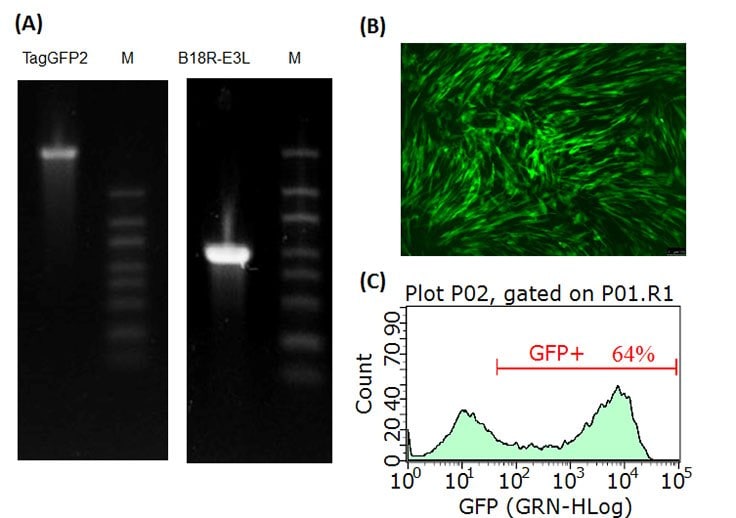
Figure 2. RNA gels and TagGFP2 expression in HFFs.(A) TagGFP2 and B18R-E3L RNA gels. Marker: 6, 4, 3, 2, 1.5, 1, 0.5, 0.2 kb. (B, C) TagGFP2 Simplicon™ RNA (E3L) (Cat. #: SCR720) and B18R-E3L RNA (Cat.#: SCR722) were co-transfected into HFFs with MessengerMax™ transfection Reagent. One day after transfection, GFP expression was analyzed by fluorescence microscopy and FACS.
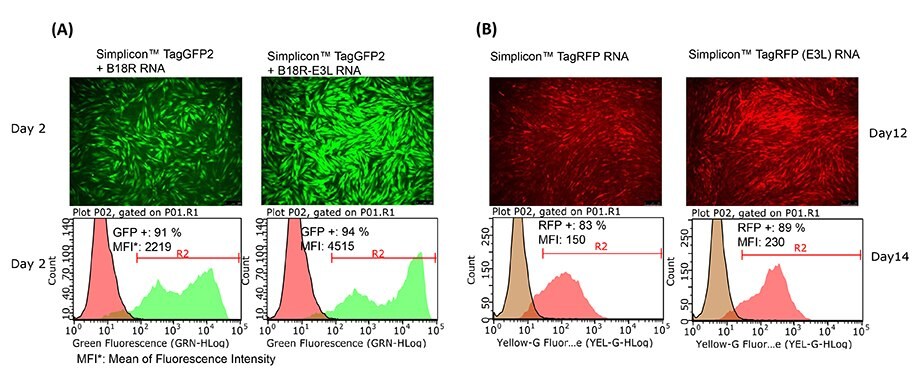
Figure 3. E3L increased Simplicon™ RNA expression levels.(A) BJ human foreskin fibroblasts were co-transfected with Simplicon™ TagGFP2 (Cat. #: SCR713M) and B18R RNA (Cat. #: SCR723) or B18R-E3L RNA (Cat. #: SCR722). (B) E3L worked for continuous expression of Simplicon™ RNA. Simplicon™ TagRFP or TagRFP Simplicon (E3L) was co-transfected with B18R-E3L RNA and cultured with medium containing B18R protein and puromycin for 14 days. RFP expressing cells were imaged on Day 12, and analyzed by FACS on Day 14.
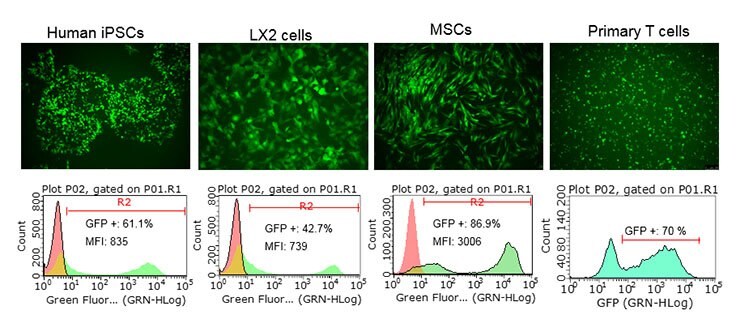
Figure 4. Simplicon™ RNA can be transfected into a wide variety of cell types.Simplicon™ TagGFP2 RNA (Cat. #: SCR713M) and B18R-RNA (Cat. #: SCR723) were co-transfected with Human iPSCs, LX2 human hepatic stellate cell line (Cat. #: SCC064), human mesenchymal stem cells (MSCs, Cat. #: SCC034) by MessengerMAX™ transfection reagent. For human primary T cells (PBMCs stimulated with CD3/CD28), electroporation method was used.
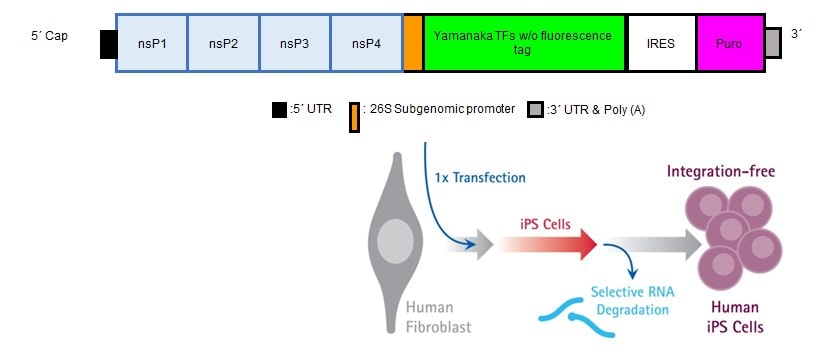
Figure 5. Human iPS cells can be genereated with a single transfection of polycistronic RNA.Once created, the reprogramming RNA can be selectively degraded by removing B18R from the culture media, creating transgene-free, replicon-free iPSCs.
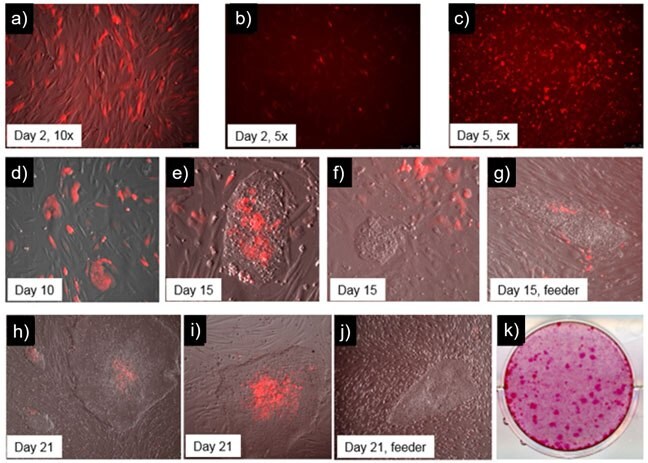
Figure 6. Time course of human iPSC colonies generated using Human Simplicon™ OKSG-cMyc TagRFP RNA(Cat #: SCR714). BJ human foreskin fibroblasts were transfected with Simplicon™-OKSG-cMyc TagRFP and B18R RNAs One day after transfection (Day 2), approximately 37% cells are RFP positive (a, b) and TagRFP expression became strong on Day 5 (c). Cells were replated on Day 7. Colonies with TagRFP positive cells on Day 10 (d). At later time points, colonies may express variable levels of TagRFP, with some expressing partial TagRFP expression (e, h, i) or not at all (f, g, j). Distinct human iPSC colonies are observed by days 21 (h, i, j). Alkaline phosphatase staining of human iPSC colonies (k).
To continue reading please sign in or create an account.
Don't Have An Account?